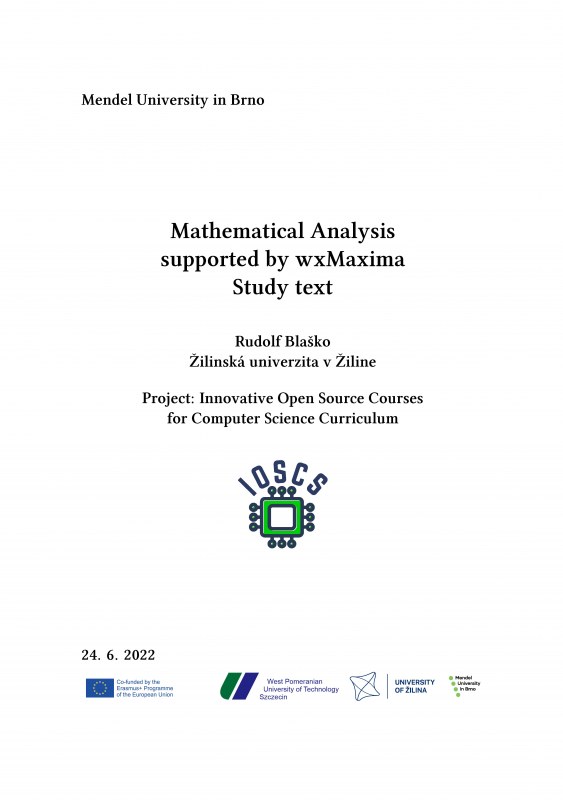
ISBN online: 978-80-7509-894-8 | DOI: 10.11118/978-80-7509-894-8
Mathematical Analysis supported by wxMaxima
Study text
- Rudolf Blaško
The mentioned textbook is one of the basic study materials for the course Mathematical analysis suported by wxMaxima. This textbook was written as one of the outputs of the project “Innovative Open Source Courses for Computer Science”, funded by the Erasmus+ grant no. 2019-1- PL01-KA203-065564. The project is coordinated by West Pomeranian University of Technology in Szczecin (Poland) and is implemented in partnership with Mendel University in Brno (Czech Republic) and University of Žilina (Slovak Republic). The project implementation timeline is September 2019 to December 2022. The course is focused on the practical teaching of Mathematical Analysis using computing technology (mainly tools for symbolic calculations). Due to the orientation of the project not on commercial programs, the Open Source tool wxMaxima (https://wxmaxima-developers. github.io/wxmaxima/) was chosen as a resource and teaching tool. wxMaxima is a highquality, easy-to-use tool for symbolic as well as numerical calculations. Together with another Open Source tool, Gnuplot, it provides a wide range of 2D and 3D visualization. The textbook is divided into five chapters. The first chapter is dedicated to the basics of working in the wxMaxima program. There is a brief description of the wxMaxima environment, working with menus, and working at the command level. Here are described basic commands for work, commands for working with constants, commands for creating functions, commands for creating graphs, commands for calculations of limits, derivatives, integrals, for calculations of sums of series, etc. All commands are illustrated with practical demonstrations. The remaining four chapters are dedicated to mathematical analysis and its teaching using wxMaxima. Some concepts and tasks are briefly described in these chapters from the theory of real functions, number sequences and number series, from differential calculus aimed at investigating the course of a function and from the integral calculus focused on the bases of the indefinite and definite integral. Subsequently, these knowledges are illustrated or solved using wxMaxima tools. All practical examples are verified in the wxMaxima 21.05.2 environment.
1. vydání, online: 2022, vydavatel: Mendel University in Brno
Reference
- Blaško R., Matematická analýza I, Žilina, EDIS 2009.
- Blaško R., Matematická analýza I, skriptum, https://frcatel.fri.utc.sk/~beerb/ma1/sa1.pdf.
- Blaško R., Neurčitý a určitý integrál reálnej funkcie, skriptum, https://frcatel.fri.utc.sk/~beerb/ma1/sa2.pdf
- Blaško R., Základy lineárnej algebry a základy matematickej analýzy pre manažérov, skriptum, https://frcatel.fri.utc.sk/~beerb/ma1/zla-zma.pdf
- Buša J., Maxima Open source systém počítačovej algebry, online, https://people.tuke.sk/jan.busa/kega/maxima/maxima.pdf, 2006.
- Bittinger M. L., Ellenbogen D. J., Surgent S. A., Calculus and its Applications, Addisok-Wesley, ISBN-10: 0-321-69433-3.
- Crowell B., Calculus, Light and Matter, www.lightandmatter.com, March 2010.
- Hannan Z., wxMaxima for Calculus I and II, Solano Community College, https://wxmaximafor.wordpress.com/
- Mardsen J., Weinstein A., Calculus I - III, Springer.
- Strang G., Calculus, Wellesley-Cambridge Press, Box 82-279 Wellesley MA 02181.


